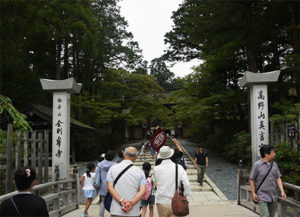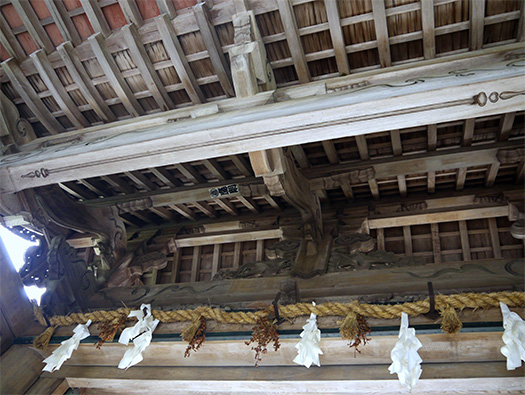


さて韓国・仏国寺から始まってしばらく法隆寺や飛鳥寺といった
建築文化の典型的発露である宗教建築を見てきました。
住宅は日本では近世初期くらいまで庶民は主に竪穴であって
一部の上澄み層で書院形式の住まいがあるという状況。
そういった時代相では宗教建築というものが建築文化を揺籃し続けてきた。
日本では仏教伝来以前から神社が存在して一種の建築的空間があった。
建築的には出雲大社のような神殿も持っていたけれど、
たぶん深い「鎮守の森」そのものが神体を象徴していた。
仏教が大陸から建築文化を伴って伝来して急速に建築がその装飾性を高めた。
そういった建築空間を庶民が体験するようになって初めて
庶民は「建築のデザイン」というものに接したのではないか。
ある宗教的な「境地」というものを空間として表現することを知って
はじめて建築に、意味性を見出しうるのだと覚醒させられた。
床の間のような「見る」「見せる」建築要素を自覚させられた。
そういった意味が日本の宗教建築の推移にはあるのだろうと思います。
・・・ということから、法隆寺の時代から時を経た高野山であります。
高野山というのは空海が開祖になった真言宗の中核寺院。816年に空海が
天皇に願い出て高野山を宗教的聖地として下賜を希望した。
605年の法隆寺起源から200年以上が経過しての開山。
家の宗旨が真言宗なので坊さんからいつも高野山行きなさいと言われていた。
半可な宗徒なのでたくさんわからないことだらけながら、
一度は体験した上で「なにがわからないかを知ること」から始めた次第。
あ、わたし、一応は般若心経はソラで唱えられます(エヘン)。
たまたま両親の葬儀前後、兄弟でリレーで「千願心経」を唱えたことがきっかけで
アタマのなかに入ってきた次第であります。
一応入ってくると、いわばカタチだけでも知れると興味は強くなる。
仏様というのは広大無辺に衆生を受け入れていただけると信じて
ありがたく出張の合間の休日に高野山にも登らせていただいた次第。
そこで撮影していた写真類にふと気付いて、整理整頓してみたのであります。
ということで、いくつか疑問を持ちつつ参詣した記録でもあります。
一番上の写真は金剛峯寺の山門であります。
真ん中写真は境内地入山の結界をあらわしている標識。
で、3枚目の写真でいきなり「あれっ!」と驚かされる。
わたしは神社ではなく仏寺に参っているのに「注連縄」であります。
念のためにWikiを確認すると「注連縄(しめなわ)は、神道における神祭具で、
糸の字の象形を成す紙垂(しで)をつけた縄。
神聖な区域とその外とを区分するための標(しめ)」とある。
広大無辺な空海さんからすると、こういうのは雑事であると高笑しているかのよう。
いきなりそういうふうに衆生を導きたまうものであるのか。
いまはもうインタビュー不可能ですが、ガツンと一発食らわされた(笑)。
English version⬇
[Japanese Religious Architecture Koyasan Kongobuji Temple-1]
By the way, starting from Bulguksa Temple in South Korea, Horyuji Temple and Asuka Temple have been called for a while.
I have seen religious architecture, which is one of the typical manifestations of architectural culture.
In Japan, the common people were mainly pit-houses until the early modern period.
The situation is that there is a Shoin-style dwelling in some of the supernatant layers.
In such an era, religious architecture has continued to undermine architectural culture.
In Japan, there was a kind of architectural space where shrines existed before the introduction of Buddhism.
Architecturally, I also had a temple like Izumo Taisha,
Perhaps the deep “Guardian Forest” itself symbolized the Shintai.
Buddhism was introduced from the continent with architectural culture, and architecture rapidly increased its decorativeness.
It is not until the common people experience such an architectural space.
The common people may have come into contact with “architectural design”.
Knowing that a religious “ground” is expressed as a space
For the first time, I was awakened that I could find meaning in architecture.
I was made aware of the architectural elements of “seeing” and “showing” like a tokonoma.
I think that such a meaning is in the transition of religious architecture in Japan.
Therefore, it is Mt. Koya that has passed since the time of Horyuji Temple.
Koyasan is the core temple of the Shingon sect, which was founded by Kukai. Kukai in 816
I asked the emperor to give him a gift with Mt. Koya as a religious sanctuary.
The mountain was opened more than 200 years after the origin of Horyuji Temple in 605.
Since the sect of the house is the Shingon sect, the boy always told me to go to Mt. Koya.
I’m a half-hearted sect, so I’m full of things I don’t understand
After experiencing it once, I started by “knowing what I don’t understand”.
Ah, for the time being, the Heart Sutra is chanted in Sora (Ehen).
It happened that before and after the funeral of my parents, my brothers chanted “Sengan Shinkyo” at the relay.
It depends on having entered the head.
Once you come in, you will become more interested if you know only the shape.
Believe that the Buddha can accept sentient beings in a vast area
Thankfully, I climbed Mt. Koya on a holiday between business trips.
There, he suddenly noticed the photographs he was taking and tried to organize them.
So, it is also a record that I visited while having some doubts.
The top photo is the gate of Kongobuji Temple.
The photo in the middle is a sign that shows the barrier of entering the precincts.
Then, the third photo suddenly surprised me with “that!”.
Even though I am visiting a Buddhist temple instead of a shrine, it is “Shimenawa”.
Just in case, I checked the Wiki and found that “Shimenawa is a Shinto ritual tool.
A rope with a paper shide that forms the shape of a thread.
It says “a mark to distinguish the sacred area from the outside.”
From the vast and open Kukai, it seems as if this is a miscellaneous matter.
Is it something that suddenly guides sentient beings in that way?
I can’t interview him anymore, but I was struck by one shot (laughs).
Posted on 10月 25th, 2021 by 三木 奎吾
Filed under: 住宅マーケティング, 日本社会・文化研究







コメントを投稿
「※誹謗中傷や、悪意のある書き込み、営利目的などのコメントを防ぐために、投稿された全てのコメントは一時的に保留されますのでご了承ください。」
You must be logged in to post a comment.